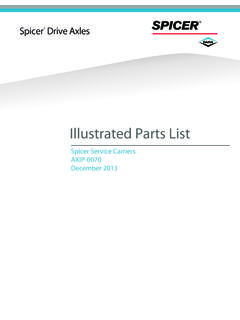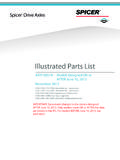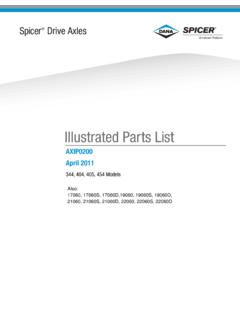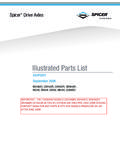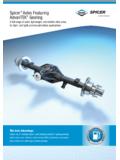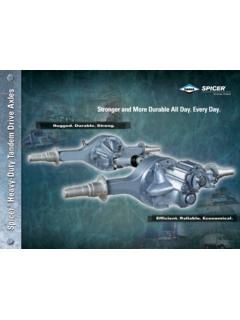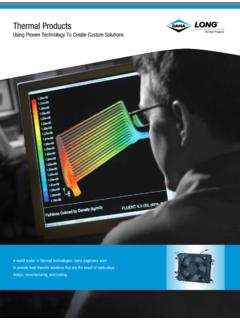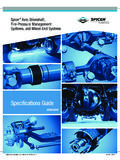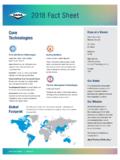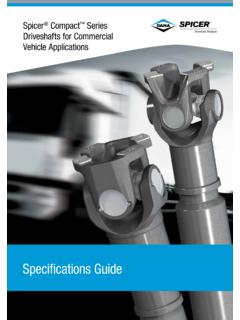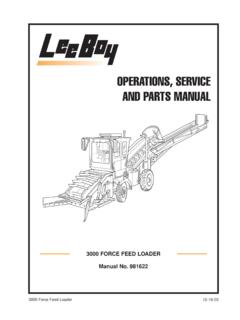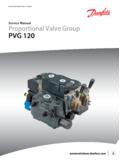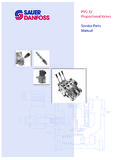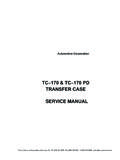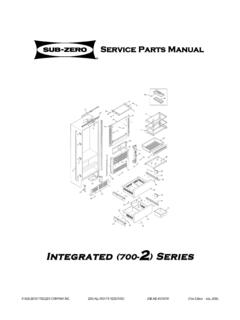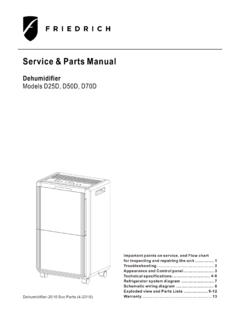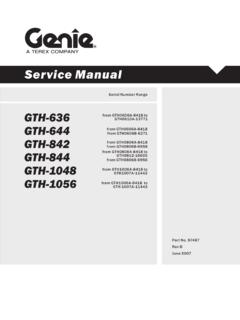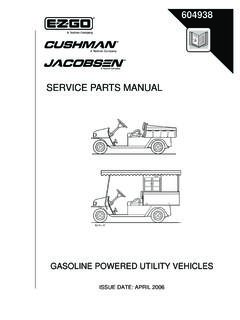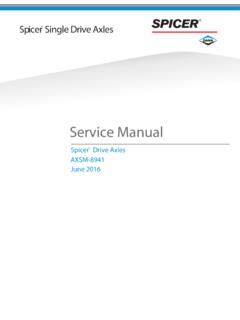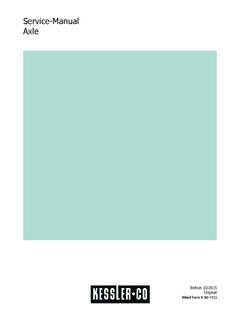Transcription of Service Manual - Dana Incorporated
1 Spicer Single Drive AxlesServi ce ManualAXSM0056 September 2013S170 SeriesS190 SeriesS590 SeriesGeneral InformationGeneral InformationThe description and specifications contained in this Service publication are current at the time of reserves the right to discontinue or to modify its models and/or procedures and to change specifications at anytime without reference to brand names in this publication is made simply as an example of the types of tools and materials recommendedfor use and should not be considered an endorsement. Equivalents, if available, may be NoticeAlways use genuine Spicer replacement symbol is used throughout thismanual to call attention to procedureswhere carelessness or failure to followspecific instructions may result inpersonal injury and/or from the instructions, choiceof tools, materials and recommendedparts mentioned in this publicationmay jeopardize the personal safetyof the Service technician or : Failure to follow indicatedprocedures creates a high risk of personalinjury to the servicing : Failure to follow indicatedprocedures may cause componentdamage or : Highly recommendedprocedures for proper Service of this : Additional Service information notcovered in the Service .
2 Helpful removal and installationprocedures to aid in the Service of this of ContentsTable of ContentsTable of ContentsWheelDifferentialAssemblypage 23 CarrierAssemblypage 7 DrivePinionpage 12 Sealspage 47 HousingBreatherpage 46 Lubricationpage 54 WheelDifferentialLockpage 40 WheelEnd Sealpage 47 General InformationIntroduction ..1 Model Identification ..2-3 Failure Analysis ..4-5 Inspection ..6 Differential Carrier Assembly - Differential Carrier ..8-9 Install Differential Carrier ..10 Remove Wheel Differential (All Standard Models) ..11 Pinion Removal ..12-13 Pinion Assembly - Parts Exploded View ..14 Drive Pinion Overhaul and Assembly ..15 -19 Wheel Differential - Parts Exploded View ..20 Wheel Differential Disassembly - Before July 2013 Forward Carrier Assembly ..21-22 Wheel Differential Assembly - Forward Carrier Assembly.
3 23-24 Install Wheel Differential Assembly - Forward Carrier Assembly ..25-29 Wheel Differential Disassembly - After July 2013 Forward Carrier Assembly ..30-31 Wheel Differential Assembly - Forward Carrier Assembly ..32-34 Install Wheel Differential Assembly - Forward Carrier Assembly ..35-37 Adjust Tooth Contact Position ..38-39 Wheel Differential Lock - Parts Exploded and Adjust Wheel Differential Lock ..41 Housing and Output Shaft Assembly - Parts Exploded View ..42 Replace Seal ..43-44 Service Kit ..45 Housing Breather ..46 Wheel End Seal - Parts Exploded View ..47 Remove and Overhaul Wheel End Seal ..48 Adjust Wheel Wheel Endplay Procedure ..51 Lubricate Wheel End ..52-53 General Lubrication Information ..54 Lube Change Intervals ..55 Change Lube ..56 Standpipes ..57-5 8 Proper Vehicle Towing.
4 59 Power Divider Operation (Power Flow and Torque Distribution) ..60-61 Operate Wheel Differential Assembly ..62 Direct Driver-Controlled System ..63 Wheel Differential Lock ..64-65 Pinion Assembly - Parts Exploded View ..66 Wheel Differential - Parts Exploded Views ..67 Wheel Differential Lock Assembly - Parts Exploded Views ..68 Housing and Output Shaft Assembly - Parts Exploded View ..69 Fastener Torque Specifications ..701 General InformationGeneral InformationIntroductionDana Commercial Vehicle Systems Division, presents thispublication to aid in maintenance and overhaul of Spicertandem drive contained cover the models listed. Their design iscommon, with differences in load capacity. Capacity variationsare achieved by combining basic differential carrier assemblieswith different axle housings, axle shafts and wheelequipment.
5 Model ListingModel InformationTh e fo llowing models are included in this publication:Heavy SinglesS21-170S26-190S21-170DS26-190DS23 -170S30-590S23-1 70DS30-190S23-1 90S30-190DS23-190DS30-190ES25-170S35-590 S26-170- - -S 23-1 7 0 DD - Dual Drive Forward Axle with Inter-Axle DifferentialG - Single Rear Axle (Global)R - Dual Drive Rear AxleS - Single Rear Axle ( )Gear Type1 - Standard Single Reduction2 - Dual Range3 - Planetary Double Reduction4 - Open5 - Helical ReductionOptionsC - Controlled TractionD - Differential LockE - High Entry SingleH - Heavy WallI - Integral BrakeL - Limited-SlipP - Lube PumpR - Retarder ReadyW - Wide-TrackDesign LevelHead Assembly SeriesGAW Ratingx 1000 lbs. (N. America) "-"x 1 Tn. (Europe) "."2 General InformationModel IdentificationDrive AxleParts IdentificationAxle HousingAxle Shaft1 - Country or origin2 - Axle model identification3 - Specification number assigned to the axle built by Spicer.
6 Identifies all component parts of the axle including special OEM requirements such as yokes or - OEM part number assigned to the axle build5 - Carrier assembly serial number assigned by the manufacturing plant6 - Axle gear ratio7 - Carrier assembly production or Service part numberRear Axle (Top View)4651327 Spicer MODEL part NO. RATIOMADE part MODEL part NO. RATIOMADE part - ID Tag1PT. CAP. M ADE INSpicer 2 - Axle shaft part number23 General InformationGeneral InformationRing Gear and PinionNote: Ring gear and drive pinion are matched parts andmust be replaced in - part number2 - Number of ring gear teeth3 - Manufacturing numbers4 - Matching gear set number5 - Number of pinion teeth6 - Date code7 - Indicates genuine Spicer parts8 - Heat code41-8 SPICER127381 OFNL2171278-41127428 SPICER17G6-39JD7785405 DANA86523178L703814L703847G31270H6864 InspectionFailure AnalysisFailure analysis is the process of determining the originalcause of a component failure in order to keep it fromhappening again.
7 Too often, when a failed component isreplaced without determining its cause, there will be a recurringfailure. If a carrier housing is opened, revealing a ringgear with a broken tooth, it is not enough to settle on the brokentooth as the cause of the carrier failure. Other parts of thecarrier must be examined. For a thorough understanding ofthe failure and possible insight into related problems, thetechnician needs to observe the overall condition of the one benefits when a failed component goes on the junkpile with the cause unknown. Nothing is more disturbing to acustomer than a repeat failure. Systematically analyzing a failureto prevent a repeat occurrence assures quality Service byavoiding unnecessary downtime and further expense to true cause of a failure can be better determined byknowing what to look for, determining how a piece of theequipment was running, and learning about previous the case of a rebuilt rear axle, mismatched gears mayhave been more successful shops prevent repeat equipment failuresby developing good failure analysis practices.
8 Knowing howto diagnose the cause of a premature failure is one of theprerequisites of a good heavy-equipment to Diagnose a FailureThe following five steps are an effective approach to goodfailure Document the Make a preliminary Prepare the parts for Find the cause of the Correct the cause of the problem. Document the ProblemHere are some guidelines for starting to learn about a failure. Talk to the operator of the truck. Look at the Service records. Find out when the truck was last the following questions: In what type of Service is the truck being used? Has this particular failure occurred before? How was the truck working prior to the failure?You need to be a good listener. Sometimes insignificant orunrelated symptoms can point to the cause of the the following questions: Was the vehicle operating at normal temperatures?
9 Were the gauges showing normal ranges of operation? Was there any unusual noise or vibration?After listening, review the previous repair and maintenancerecords. If there is more than one driver, talk to all of themand compare their observations for consistency with theservice and maintenance records. Verify the chassis VehicleIdentification Number (VIN) number from the vehicle identificationplate, as well as the mileage and hours on the a Preliminar y In vestigationThese steps consist of external inspections and observations that will be valuable when combined with the results of the parts examination. Look for leaks, cracks or other damage that can point to the cause of the failure. Make no te of obvious leaks around plugs and seals. A missing fill or drain plug would be an obvious cause for concern.
10 Look for cracks in the carrier housing (harder to see, but sometimes visible). Does the general mechanical condition of the vehicle indicate proper maintenance or are there signs of neglect? Are the tires in good condition and do the sizes match? If equipped with a to rque-limiting device, is it work-ing properly?During the preliminary investigation, write down anything out of the or dinary fo r later reference. Items that appear insignificant now may take on more importance when the subassemblies are torn the Parts for InspectionAfter the preliminary investigation, locate the failure and pre-pare the part for examination. In carrier failure analysis, it may be necessary to disassemble the unit. When disassembling subassemblies and parts, do not clean the parts immediately since cleaning may destroy some of the evidence.
